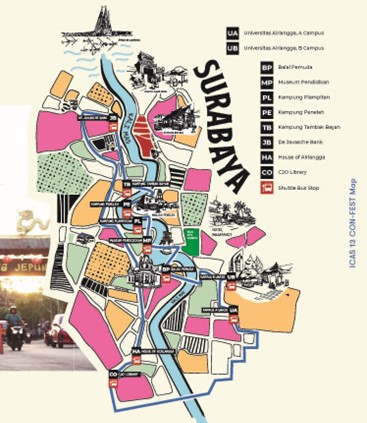City as Stage: Utilizing Multiple Venues for ICAS 13
Since ICAS 11 ventured out and utilized Leiden's existing infrastructure and offered opportunities for the participants to get acquainted with the locality and its people, "local embedment" has become one of ICAS' key principles. At ICAS 13, we embarked on the journey to accentuate multiple facets of Surabaya by hosting exhibitions, workshops, book talks, and discussion sessions at various locations outside Universitas Airlangga (UNAIR).
Surabaya's vibrancy was represented architecturally by historical monuments such as De Javasche Bank, Balai Pemuda, and Museum Pendidikan. The Han Ancestral House showed the intertwined history of the Peranakan Chinese and Javanese. Kampung Baru, Streng Kali Jagir, Peneleh, Plampitan, and Tambak Bayan constituted the arts of local and human-scale living amidst this ever-bustling and larger-than-life city.

Fig. 2: ICAS 13 Conference-Festival Map. Illustrated by Redo Nomadore (Surabaya). Excerpt of ICAS 13 Programme Book, page 15.
Providing such a diverse range of experiences was undeniably a strenuous effort. We quickly realized logistics and transportation would be more complex than in European cities. However, we were not alone in this, as the collaboration with local partners was instrumental in the success of ICAS 13. Ibu Lisa Wahyuningtyasti and her Universitas Airlangga Transportation Department team worked closely with us to map out the shuttle routes and schedules, mobilizing participants between UNAIR campuses, hotels, and all festival locations. The Surabaya City Council also played a crucial role in sponsoring transportation and venue access.
All in all, ICAS 13 was an ICAS extraordinaire. How did we pull that off? How did we offer the bite-size experience of Surabaya? It would not have succeeded without contributions of ICAS 13 participants, partner institutions, local collaborators and coordinators, Surabaya city and its people, UNAIR colleagues, AIIOC team, and everyone at IIAS. Thank you!